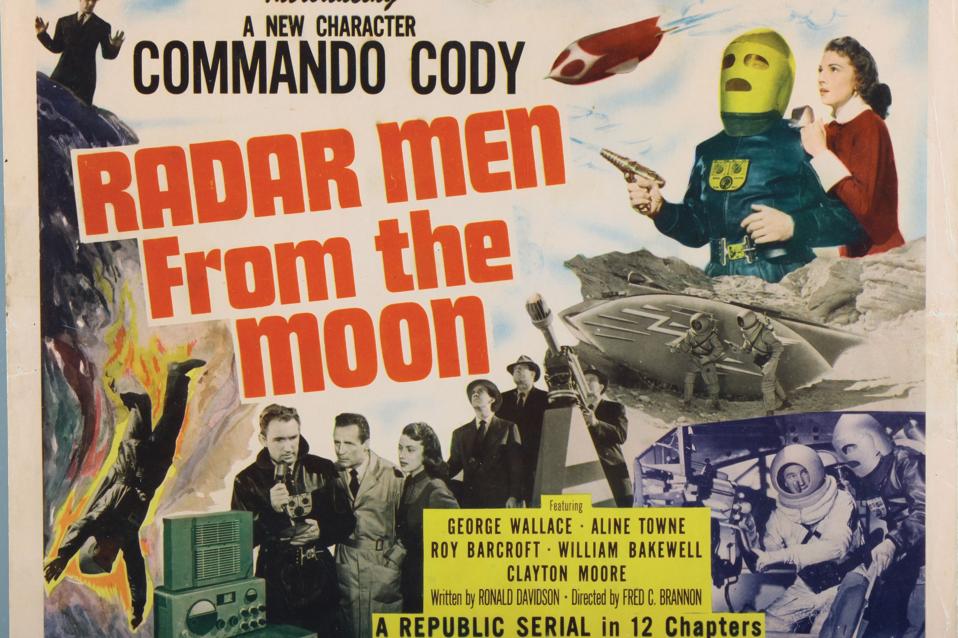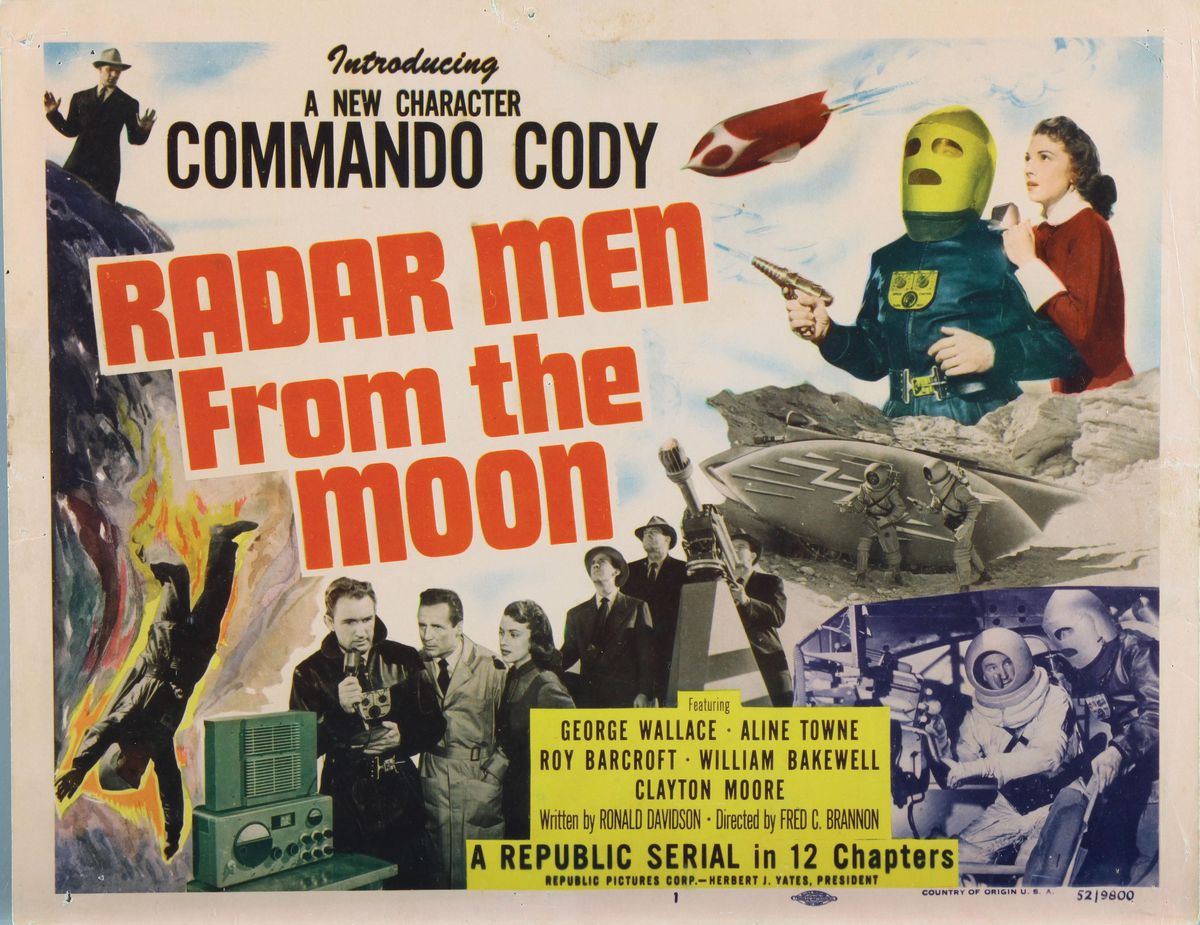
Radar Men From The Moon, poster, lobbycard, title card, George Wallace (helmet), Aline Towne (top … [+]
LMPC via Getty Images
America’s first “moon shot” succeeded 75 years ago today. For the first time, a team of U.S. Army engineers bounced a radar signal off the surface of the Moon and captured its echoes here on Earth. The effort, called Project Diana, laid the groundwork for radio communications with spacecraft, radar missile defense systems, and mapping the surfaces of our nearest planetary neighbors.
In the wake of World War II, the world was reckoning with the frightening implications of destructive new kinds of warfare, especially long-range missiles like Germany’s V2 rockets and atomic bombs like those the U.S. dropped on Hiroshima and Nagasaki in Japan.
“During the war the Germans used the V2 Rocket, which climbed some 70 miles above the Earth, and the future holds the unhappy prospect of missiles going far higher than this,” wrote Jack Mofenson, a Project Diana researcher. Mofenson was right; modern intercontinental ballistic missiles blast upwards 1,200 miles before plummeting toward their targets. As Mofenson put it, “The matter of transmission of radio signals to great distances above the earth for detection and control of such weapons becomes a problem of military importance.”
So the Department of War (which was reorganized and renamed the Department of Defense by 1949) wanted to know if radar could help detect missiles diving toward Earth from space. But as far as scientists knew in late 1945, any ballistic missile re-entering Earth’s atmosphere would have a natural cloaking device: the outer layer of Earth’s atmosphere, where the Sun’s ultraviolet radiation strips electrons from molecules, leaving a mix of ions and stray electrons surrounding the planet. This layer, called the ionosphere, starts around 50 miles from the surface and extends a few hundred miles out into space.
The ionosphere is where the dancing lights of the aurora borealis and aurora australis happen. All that electromagnetic activity and solar radiation also have strange effects on radio waves, which are the basis of radar. In general, the ionosphere tends to scatter radio waves; sometimes, if the transmitter is at just the right angle, that means a signal from one place can bounce off the ionosphere and reach a radio receiver on another continent.
(Side note: about 30 years ago, your faithful correspondent’s father was using a handheld radio on his shift at a Houston, TX-area paper mill one night when he accidentally reached a deputy sheriff somewhere in Arizona. After some mutually confused “what are you doing on this channel?” they both figured it out and had a nice chat.)
Because the ionosphere tends to reflect and also scatter, or refract, radio waves, especially short-wave or high-frequency waves, engineers and scientists in 1946 weren’t entirely sure if radar could “see” through the layer to detect an incoming missile.
In the 1920s, a team of researchers had bounced a radar signal off the lower edge of the ionosphere to measure its altitude. Now the Pentagon was asking its scientists to aim even higher. The math suggested that it was theoretically possible, but with the Cold War already looming on the horizon, theory wasn’t enough.
Starting in September 1945, just a month after the end of the war, Col. John DeWitt, Jr., and his team started building the massive radio transmitter, receiver, and antenna array they would need for the job. They used a mixture of specially-built parts and modified equipment left over from World War II. Camp Evans, where DeWitt became director of the Army’s Evans Signal Laboratory, was a patch of land with an eventful history.
In 1914, a few months before the start of World War I, the Marconi Wireless Telegraph Company set up the Belmar Receiving Station for trans-Atlantic messages. Marconi strung a mile of bronze antenna, supported by 400-foot-high towers, along the Shark River near Wall Township, New Jersey. During the war, the U.S. Army acquired the land and built a Signal Corps camp there; when the war ended, Marconi took over again and sold the land to RCA – who eventually sold it to a group that turned out to be the New Jersey chapter of the racist terrorist organization, the Ku Klux Klan.
The Army took control of the land again in 1942, and after the war Camp Evans became the home of Project Diana.
Through the fall and winter of 1945, engineers and physicists built their lunar radar station and figured out the math that would make the whole thing work. Objects in space are constantly moving in relation to each other. By the time a radio signal reached the Moon, reflected of the lunar surface, and bounced back, the changing distance between the Moon and Camp Evans would stretch the waves into a different frequency. (This is called the Doppler Effect.)
DeWitt’s team had to calculate that effect every time they aimed a burst of radio waves at the Moon, because they needed to know which frequency to listen to for the returning echoes.
They also had to get the timing just right: their antennae pointed at the horizon and could only rotate in two dimensions, so the Project Diana team had less than hour every day, divided up between moonrise and moonset, to try to shoot the Moon. That still gave them a lot of chances, though. DeWitt and his team fired a 0.25-second pulse of radio waves at the Moon once every five seconds. Radio waves moving at the speed of light take about 2.5 seconds to cross the roughly 239,000 miles to the Moon, and then another 2.5 seconds to make the return trip.
And at 11:58 AM Eastern Time on January 10, 1946, a radio pulse DeWitt’s team had transmitted five seconds earlier returned to their receivers – after echoing off the distant surface of the Moon.
Thanks to Project Diana, we now have radar installations that can detect an incoming ICBM (or track Santa’s sleigh every Christmas Eve). We can also use radios to communicate with astronauts in space or send instructions to robotic spacecraft like Voyagers 1 and 2, the Lunar Reconnaissance Orbiter, and the Curiosity Rover. Project Diana also paved the way for radar astronomy, which uses reflected radar signals to study the shapes, rotation, and surface properties of objects in space, ranging from near-Earth asteroids to Saturn’s rings and the surface of Venus.
This article is auto-generated by Algorithm Source: www.forbes.com


